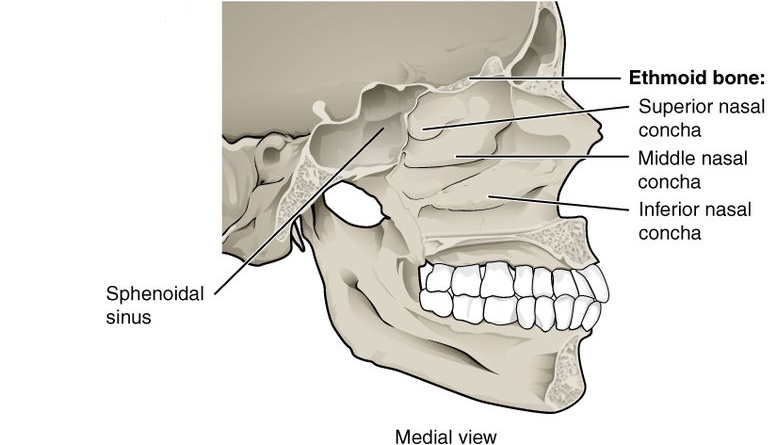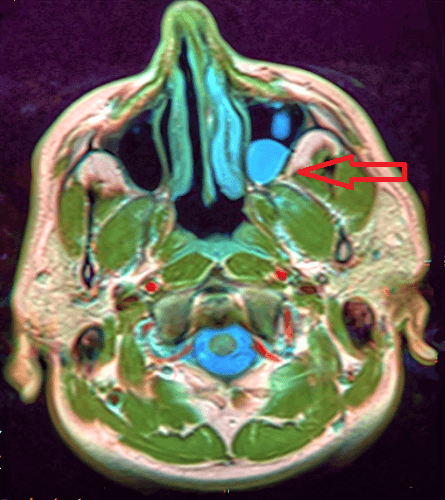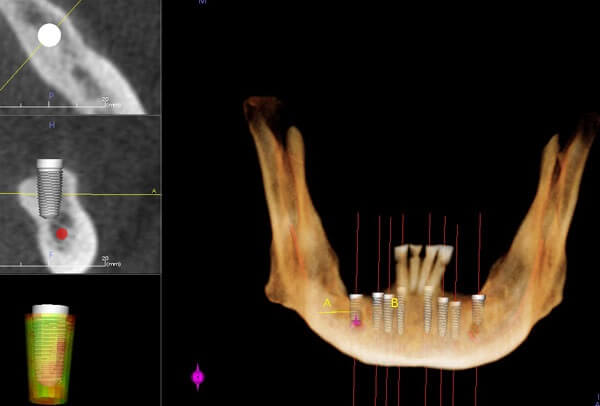Definition
The facial bones (viscerocranium) make up most of the front of the skull. The bones responsible for the form of the face are – from top to bottom – the inferior nasal conchae and the nasal, maxilla, zygomatic, lacrimal, ethmoid, vomer, sphenoid, palatine, and mandible bones. The ethmoid and sphenoid bones are also part of the neurocranium.

What Are Facial Bones?
The facial bones support the many muscles and soft tissues of the face, head, and neck. The form of your face is largely due to the shape of your facial skeleton. These multiple bones also feature foramina (holes) that allow important cranial nerves and blood supply to cross from the inside to the outside surfaces and vice versa.
Each bone articulates (joins) with neighboring bones. These can be direct joints or joints between processes – protrusions from the body of each structure. For example, the orbital bones of the eye sockets are not bones in themselves but articulating parts of the sphenoid, frontal, zygomatic, ethmoid, lacrimal, maxilla, and palatine bones.

How Many Facial Bones Are There?
If you are asked how many facial bones there are, there is no fixed answer. This is because, as already mentioned, some bones of the face are also part of the neurocranium (the bony covering of the brain). Alternatively, some anatomists do not count the mandible, as this bone is only attached to the skull via ligaments (at the temporomandibular joint); it only directly joins to its paired half through the length of the chin.

This means that your answer can vary but still be correct. It is safer to list all candidates, with a short description of how they articulate with their neighbors.
Your answer could list 14 facial bones, 12 facial bones, or even 17 facial bones depending on which anatomy textbook you consult.
The answer that will earn maximum points is the following:
The facial bones number between twelve (not counting the mandible) and seventeen bones according to various sources.
- 1 sphenoid bone: located behind the eye sockets; stretches from one side of the cranium to the other; sometimes not included in the list of facial bones as it is also part of the neurocranium; articulates with the frontal, parietal, temporal, occipital, ethmoid, zygomatic, palatine, and vomer bones.
- 2 inferior nasal conchae (paired); located at the top of the nasal cavity; articulate with the maxilla, palatine, lacrimal, and ethmoid bones.
- 2 nasal bones (paired); located at the bridge of the nose; articulate with the frontal, ethmoid, and maxilla bones, as well as with each other.
- 2 lacrimal bones (paired); located on the inside surface of the eye socket; articulate with the maxilla, ethmoid, and frontal bone and with the inferior nasal concha.
- 1 ethmoid bone; located behind the upper nasal cavity and in front of the brain; sometimes not included in the list of facial bones as it is also part of the neurocranium; articulates with the frontal, sphenoid, nasal, maxilla, lacrimal, palatine, and vomer bones and with the inferior nasal concha.
- 2 palatine bones (paired); located at the back of the nasal cavity at the hard palate; articulate with the sphenoid, maxilla, ethmoid, and vomer bones. Also with the inferior nasal concha and each other.
- 1 vomer; located at the bottom of the nasal septum and above the hard palate; articulates with the maxilla, palatine, and ethmoid bones.
- 2 zygomatic bones (paired); located at the upper cheek; articulates with the temporal, frontal, maxilla, and sphenoid bones.
- 1 (or 2) maxilla bones (paired but fused); located in the upper jaw; articulate with the highest number of other bones: the frontal, ethmoid, nasal, zygomatic, lacrimal, palatine, and vomer bones and with the inferior nasal concha and each other.
- 1 (or 2) mandible; located in the lower jaw. Only articulates directly with its opposite partner at the chin; forms a synovial joint with the temporal fossa of the temporal bone (temporomandibular joint).
To receive optimum points, a diagram with labeled facial bones will show that you understand how each bone contributes to the face.

The above facial bone diagram does not include the ethmoid and sphenoid bones. They are only labeled as part of the cranium.
Facial Bones Function
The facial bones have many functions, as each individual bone supports different areas of the face.
Firstly, the facial bones protect the soft tissues that lie underneath, such as the mucous membranes and sensory cells of the nasal cavity, the oral cavity, the eyes, and – if the ethmoid is included – the pituitary gland of the brain.

Foramina in the facial bones, such as the zygomaticofacial foramen in the zygomatic bone, allow blood vessels and nerves to travel through the facial skeleton. Grooves also create channels through which soft tissue can travel, and indentations for other structures, such as the facial bone paranasal sinuses. The below image shows a cyst inside the maxillary sinus, one of the paranasal group. The sinuses play important roles in our immunity and lung health.

The outer surfaces of the facial bones provide plenty of attachment points for muscles and ligaments that allow us to produce a wide variety of facial expressions, like frowning and smiling.
These muscles are also essential for speech, chewing, and swallowing. In the case of the mandible, other muscles attach lower in the neck and can make the lower jaw drop.

It is our facial skeleton that supports the skin and mucous membranes. The maxilla supports the upper lip, the mandible the lower lip. The nasal bones and vomer provide attachment points for the cartilage of the septum and nose tip. The size of the zygomatic bone defines whether we have high cheekbones or not. The alveolar bone of the upper and lower jaw provides sockets for our teeth.
A facial fracture, therefore, can cause a whole range of symptoms and short- or long-term complications. These range from loss of smell to jaw sensitivity, and loss of vision to facial disfigurement. One of the toughest challenges for maxillofacial surgeons is the nasoorbitoethmoid fracture that is caused by blunt force injury between the eyes.
Facial fractures are usually categorized according to the La Fort system. La Fort I is a fracture of the maxilla. La Fort II describes fractures in the area surrounding the nose. La Fort III adds the eye orbits and the cheekbones to the affected structures of La Fort I and II.

Cranial vs Facial Bones
Cranial and facial bones are not the same. Cranial bones make up the neurocranium – the casing that protects the cerebrum, cerebellum, and brainstem. Color codes relating to the following cranial bone image are:
- Yellow: frontal bone
- Blue: parietal bones
- Orange: temporal bones
- Green: occipital bone
- Pink: sphenoid bone
- Red: ethmoid bone

The bones that make up the neurocranium are the singular occipital, frontal, sphenoid, and ethmoid bones, and the paired temporal and parietal bones. The neurocranium is, therefore, composed of eight bones.
As we have already seen, the facial bones sometimes include the sphenoid and ethmoid bones, and sometimes not. Also, some of the bones of the face (such as the mandible and maxilla) are considered both singular or paired. This means the facial bones can number anywhere between twelve and seventeen.
A list of the different bones of the entire axial skeleton can be found on the cancer.gov website. This reliable source lists a total of 8 cranial bones and 14 facial bones.
Facial Bones – Medical Imaging
Facial bone x-rays give a strictly two-dimensional image. A 3-D facial bone CT is much preferred by maxillofacial surgeons as this shows distances and distinctly more detail than an x-ray.

In the facial bone x-ray above, it is hard to see where the different bones join and how far back they go. It is possible to see a facial bone fracture but no surgeon will attempt to rectify a depressed facial fracture with only x-ray imagery. Similarly, otolaryngologists who treat problems related to the ear, nose, and throat cannot view soft tissue via an x-ray.
In a facial bone CT, every structure is highly visible; individual components can be carefully measured. The newest medical imaging techniques produce images that can be rotated to provide multiple 3D views. Both magnetic resonance imaging and computed tomography images can achieve an excellent level of accuracy and extensive image rotation angles.
Orthodontists often use 3D technology to in preparation for complex dental procedures, as seen in the correct positioning of a set of tooth implants below.

